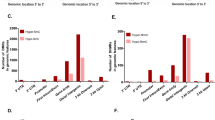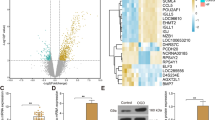Abstract
Keshan disease (KD) is a fatal dilated cardiomyopathy with unknown etiology, and selenium deficiency is considered the main cause of KD. Several observations implicate a role for altered DNA methylation in selenium deficiency-related diseases. The aim of the present study was to investigate the epigenetic effects of selenium (Se) on DNA methylation and gene expression in Keshan disease. Using methylated DNA immunoprecipitation chip (MeDIP-Chip) and quantitative RT-PCR, we identified two inflammatory-related genes (TLR2 and ICAM1) that were differentially methylated and expressed between normal individuals and KD patients. Results from DNA methylation profile between KD patients and normal individuals showed that selenium deficiency decreased methylation of CpG islands in promoter regions of TLR2 and ICAM1 and upregulated messenger RNA (mRNA) and protein levels of TLR2 and ICAM1. In rat animal model of Keshan disease, selenite treatment could increase TLR2 and ICAM1 promoter methylation, suppress these genes expression, and reduce infiltration of myocardial inflammatory cells. In cell culture model of Keshan disease, we found 5-Aza-dC (DNMT1 inhibitor) treatment in the presence of selenium-reduced mRNA and protein levels of DNMT1 regardless of TLR2 and ICAM1 promoter methylation status and expression levels of these genes. Selenite treatment suppressed the expression of the Gadd45α, TLR2, and ICAM1 in a concentration-dependent manner, while selenium deficiency increased the expression of the Gadd45α, TLR2, and ICAM1 and decreased TLR2 and ICAM1 promoter methylation level in a time-dependent manner. Our results revealed that TLR2-ICAM1-Gadd45α axis might play an important role in gene-specific active DNA demethylation during inflammatory response in myocardium.





Similar content being viewed by others
References
Li Q, Liu M, Hou J, Jiang C, Li S, Wang T (2013) The prevalence of Keshan disease in China. Int J Cardiol 168:1121–1126
Hou J, Wang T, Liu M, Li S, Chen J, Liu C et al (2011) Suboptimal selenium supply—a continuing problem in Keshan disease areas in Heilongjiang province. Biol Trace Elem Res 143:1255–1263
Xiang Y, Wang X, Wang J, Zhang W, Song S, Wang L et al (2010) Surveys on the conditions of Keshan disease and selenium levels of 15 counties in Shandong Province in 2008. Wei Sheng Yan Jiu 39:466–468
Cai W, Deng JY, Ouyang B, Li P, Li F, Zhou DY et al (2009) Surveillance on Keshan disease from 1990 to 2008 in Sichuan province. Zhonghua Liu Xing Bing Xue Za Zhi 30:820–823
Yang JY, Wang T, Wu CJ, Liu CB (2010) Selenium level surveillance for the year 2007 of Keshan disease in endemic areas and analysis on surveillance results between 2003 and 2007. Biol Trace Elem Res 138:53–59
Fairweather-Tait SJ, Bao Y, Broadley MR, Collings R, Ford D, Hesketh JE et al (2011) Selenium in human health and disease. Antioxid Redox Signal 14:1337–1383
Chen J (2012) An original discovery: selenium deficiency and Keshan disease (an endemic heart disease). Asia Pac J Clin Nutr 21:320–326
Fuyu Y (2006) Keshan disease and mitochondrial cardiomyopathy. Sci China Ser C Life Sci 49:513–518
Zagrodzki P, Laszczyk P (2006) Selenium and cardiovascular disease: selected issues. Postepy Hig Med Dosw 60:624–631 (Online)
Hooven LA, Butler J, Ream LW, Whanger PD (2006) Microarray analysis of selenium-depleted and selenium-supplemented mice. Biol Trace Elem Res 109:173–179
Badeaux AI, Shi Y (2013) Emerging roles for chromatin as a signal integration and storage platform. Nat Rev Mol Cell Biol 14:211–224
Asrih M, Steffens S (2013) Emerging role of epigenetics and miRNA in diabetic cardiomyopathy. Cardiovasc Pathol 22:117–125
Haas J, Frese KS, Park YJ, Keller A, Vogel B, Lindroth AM et al (2013) Alterations in cardiac DNA methylation in human dilated cardiomyopathy. EMBO Mol Med 5:413–429
Webster AL, Yan MS, Marsden PA (2013) Epigenetics and cardiovascular disease. Can J Cardiol 29:46–57
Severin PM, Zou X, Gaub HE, Schulten K (2011) Cytosine methylation alters DNA mechanical properties. Nucleic Acids Res 39:8740–8751
Yang J, Lior-Hoffmann L, Wang S, Zhang Y, Broyde S (2013) DNA cytosine methylation: structural and thermodynamic characterization of the epigenetic marking mechanism. Biochemistry 52:2828–2838
Fahy J, Jeltsch A, Arimondo PB (2012) DNA methyltransferase inhibitors in cancer: a chemical and therapeutic patent overview and selected clinical studies. Expert Opin Ther Pat 22:1427–1442
Foulks JM, Parnell KM, Nix RN, Chau S, Swierczek K, Saunders M et al (2012) Epigenetic drug discovery: targeting DNA methyltransferases. J Biomol Screen 17:2–17
Ren J, Singh BN, Huang Q, Li Z, Gao Y, Mishra P et al (2011) DNA hypermethylation as a chemotherapy target. Cell Signal 23:1082–1093
Gao M, Guo N, Huang C, Song L (2009) Diverse roles of GADD45alpha in stress signaling. Curr Protein Pept Sci 10:388–394
Rosemary Siafakas A, Richardson DR (2009) Growth arrest and DNA damage-45 alpha (GADD45alpha). Int J Biochem Cell Biol 41:986–989
Li Y, Zhao M, Yin H, Gao F, Wu X, Luo Y et al (2010) Overexpression of the growth arrest and DNA damage-induced 45alpha gene contributes to autoimmunity by promoting DNA demethylation in lupus T cells. Arthritis Rheum 62:1438–1447
Barreto G, Schafer A, Marhold J, Stach D, Swaminathan SK, Handa V et al (2007) Gadd45a promotes epigenetic gene activation by repair-mediated DNA demethylation. Nature 445:671–675
Lee B, Morano A, Porcellini A, Muller MT (2012) GADD45alpha inhibition of DNMT1 dependent DNA methylation during homology directed DNA repair. Nucleic Acids Res 40:2481–2493
Chan S, Gerson B, Subramaniam S (1998) The role of copper, molybdenum, selenium, and zinc in nutrition and health. Clin Lab Med 18:673–685
Schomburg L, Schweizer U, Kohrle J (2004) Selenium and selenoproteins in mammals: extraordinary, essential, enigmatic. Cell Mol Life Sci 61:1988–1995
Behne D, Kyriakopoulos A (2001) Mammalian selenium-containing proteins. Annu Rev Nutr 21:453–473
Brown KM, Arthur JR (2001) Selenium, selenoproteins and human health: a review. Public Health Nutr 4:593–599
Uthus EO, Ross SA, Davis CD (2006) Differential effects of dietary selenium (se) and folate on methyl metabolism in liver and colon of rats. Biol Trace Elem Res 109:201–214
Thomson CD (2004) Assessment of requirements for selenium and adequacy of selenium status: a review. Eur J Clin Nutr 58:391–402
Liu Y, Chiba M, Inaba Y, Kondo M (2002) Keshan disease—a review from the aspect of history and etiology. Nihon Eiseigaku Zasshi 56:641–648
China State Bureau of Technical Supervision (1997) The diagnostic standard of the Keshan disease (GB 17021–1997 Diagnostic standard for Keshan disease, China)
Hao DQ, Xie GH, Zhang YM, Tian GJ (1996) Determination of serum selenium by hydride generation flame atomic absorption spectrometry. Talanta 43:595–600
Afridi HI, Kazi TG, Kazi N, Shah AQ, Khan S et al (2012) Evaluation of calcium, magnesium, potassium, and sodium in biological samples (scalp hair, serum, blood, and urine) of Pakistani referents and arthritis patients of different age groups. Clin Lab 58:7–18
Shuto T, Furuta T, Oba M, Xu H, Li JD, Cheung J et al (2006) Promoter hypomethylation of Toll-like receptor-2 gene is associated with increased proinflammatory response toward bacterial peptidoglycan in cystic fibrosis bronchial epithelial cells. FASEB J 20:782–784
Baccarelli A, Tarantini L, Wright RO, Bollati V, Litonjua AA, Zanobetti A, et al.(2010) Repetitive element DNA methylation and circulating endothelial and inflammation markers in the VA normative aging study. Epigenetics 5.
Sawa Y, Ueki T, Hata M, Iwasawa K, Tsuruga E, Kojima H et al (2008) LPS-induced IL-6, IL-8, VCAM-1, and ICAM-1 expression in human lymphatic endothelium. J Histochem Cytochem 56:97–109
Wu HS, Zhang L, Chen Y, Guo XJ, Wang L, Xu JB et al (2005) Effect of nitric oxide on toll-like receptor 2 and 4 gene expression in rats with acute lung injury complicated by acute hemorrhage necrotizing pancreatitis. Hepato-Biliary-Pancreat Dis Int 4:609–613
Feng J, Zhou Y, Campbell SL, Le T, Li E, Sweatt JD et al (2010) Dnmt1 and Dnmt3a maintain DNA methylation and regulate synaptic function in adult forebrain neurons. Nat Neurosci 13:423–430
Lokuta A, Kirby MS, Gaa ST, Lederer WJ, Rogers TB (1994) On establishing primary cultures of neonatal rat ventricular myocytes for analysis over long periods. J Cardiovasc Electrophysiol 5:50–62
Weng YI, Huang TH, Yan PS (2009) Methylated DNA immunoprecipitation and microarray-based analysis: detection of DNA methylation in breast cancer cell lines. Methods Mol Biol 590:165–176
Yang GQ, Xia YM (1995) Studies on human dietary requirements and safe range of dietary intakes of selenium in China and their application in the prevention of related endemic diseases. Biomed Environ Sci 8:187–201
Yu SR, Liu XJ, Wang YH, Liu J (1995) A survey of moniliformin contamination in rice and corn from Keshan disease endemic and non-KSD areas in China. Biomed Environ Sci 8:330–334
Delaval K, Feil R (2004) Epigenetic regulation of mammalian genomic imprinting. Curr Opin Genet Dev 14:188–195
Jaenisch R, Bird A (2003) Epigenetic regulation of gene expression: how the genome integrates intrinsic and environmental signals. Nat Genet 33(Suppl):245–254
Rodriguez-Rodero S, Fernandez-Morera JL, Fernandez AF, Menendez-Torre E, Fraga MF (2010) Epigenetic regulation of aging. Discov Med 10:225–233
Slotkin RK, Martienssen R (2007) Transposable elements and the epigenetic regulation of the genome. Nat Rev Genet 8:272–285
Ferguson LR, Tatham AL, Lin Z, Denny WA (2011) Epigenetic regulation of gene expression as an anticancer drug target. Curr Cancer Drug Targets 11:199–212
Saliba W, El Fakih R, Shaheen W (2010) Heart failure secondary to selenium deficiency, reversible after supplementation. Int J Cardiol 141:e26–e27
Davis CD, Uthus EO (2002) Dietary selenite and azadeoxycytidine treatments affect dimethylhydrazine-induced aberrant crypt formation in rat colon and DNA methylation in HT-29 cells. J Nutr 132:292–297
Lei C, Niu X, Wei J, Zhu J, Zhu Y (2009) Interaction of glutathione peroxidase-1 and selenium in endemic dilated cardiomyopathy. Clin Chim Acta 399:102–108
Barbosa KB, Volp AC, Hermsdorff HH, Navarro-Blasco I, Zulet MA, Martinez JA et al (2011) Relationship of oxidized low density lipoprotein with lipid profile and oxidative stress markers in healthy young adults: a translational study. Lipids Health Dis 10:61
Acknowledgments
This work was supported by the Chinese national natural science fund project approval (NO-30972557), (NO-81170290).
Authorship
Xiaolin Niu and Jin Wei conceived and designed the study. Guang Yang performed the experiment, analyzed and interpreted the data, and wrote the initial draft of the manuscript. Yanhe Zhu, Xin Dong, and Zongming Duan contributed to the experimental design, the statistical analysis, and the writing of the manuscript.
Conflict of interest
The authors declare that they have no conflict of interest.
Author information
Authors and Affiliations
Corresponding author
Electronic supplementary material
Below is the link to the electronic supplementary material.
ESM 1
(PPT 1080 kb)
Rights and permissions
About this article
Cite this article
Yang, G., Zhu, Y., Dong, X. et al. TLR2-ICAM1-Gadd45α Axis Mediates the Epigenetic Effect of Selenium on DNA Methylation and Gene Expression in Keshan Disease. Biol Trace Elem Res 159, 69–80 (2014). https://doi.org/10.1007/s12011-014-9985-8
Received:
Accepted:
Published:
Issue Date:
DOI: https://doi.org/10.1007/s12011-014-9985-8




